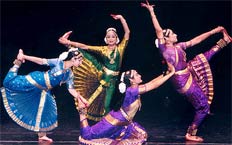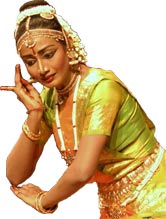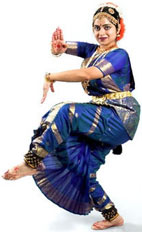BHARATANATYAM
Origin
Bharatanatyam was the dance technique in India which evolved in the South of India in Tamil Nadu and practiced in the temples of Shiva. For many centuries Bharatanatyam has been performed only by certain families in the district of Tanjore, these inheritors of the craft being known as 'Nattuvans'.The chief exponents of this particular dance were the Devadasis or temple dancers. They would perform the dance daily at the time of worship or on festive occasions. It came to be patronized by the Rajas and princes. In course of time Devadasis started dancing in the royal courts and thus its religious sanctity was lost.
About three millenniums ago, Bharata wrote an exhaustive treatise on the three "plastic" arts of India: music, dance and drama. The "Natya Sastra" included a detailed section on every minute aspect of the art of dance. The Indian Classical art form Bharatanatyam remains pure today because of Bharata's instructions and its practitioner's devotion.

Bharatanatyam is a classical dance style of South India that combines artistic expression with a sense of spirituality. There are highly trained dancers who perform precise hand gestures, use intricate footwork, vivid facial expression, and fluid movement. The Bharatanatyam dancers wear traditional costumes consisting of specially made saris, jewelry and hair ornaments, and specifically applied facial and body make-up. The dancers generally dance to a traditional south Indian Carnatic orchestra consisting of voice, strings, percussion, and flute.
Bharatanatyam, which originates from the state of Tamil Nadu in South India, is one of the most popular dance styles in India. A popular interpretation of the name of the style is: BHAva (expression) + RAga (musical mode) + TAla (rhythm) NATYAM (dance) = BHARATANATYAM.
The highly cultivated art of Bharatanatyam has been handed down over the centuries by teachers called nattuvanars and ritualistic dancers called devadasis, in the temples of south India.
 This style is a direct descendant of devotional dances performed in the temples of South India from the tenth century to the middle of this century.
This style is a direct descendant of devotional dances performed in the temples of South India from the tenth century to the middle of this century.There are three elements of Bharatanatyam called Nritta, Nritya and Natya.
- Nritta : The emphasis is on pure dance movements, creating patterns in space and time, mostly along straight lines, triangles, circles and semicircles; without any specific intention of projecting any emotion.
- Nritya: Combination of Rhythm with Expression. The dancer conveys the meanings of a lyrical passage set to music, through stylised hand gestures, facial expressions and bodily movements.
- Natya: Dramatic Element. Performing for a theme like Ramayana, Mahabharata etc.
Steps involved in the dance
It isa highly specialised science with and mixture of traditional background and rigid codes and conventions. Bharatanatyam constitutes three primary ingredients of dancing which includes bhava or mood, raga or music and melody and tala or timing. The technique of Bharatanatyam classical dance consists of 64 principles of coordinated hand, foot, face and body movements which are performed to the accompaniment of dance syllables.Bharatanatyam is usually performed with the knees of the dancers bent. The dance form emphasizes on the hand movements to convey different kinds of emotions to the spectator. While performing Bharatanatyam, the artist visualizes his/her body as made up of triangles. The steps of the dance are based upon the dancers balanced distribution of body weight and firm positions of the lower limbs, allowing the hands to cut into a line, to flow around the body, or to take positions that enhance the basic form. In order to perform Bharatnatyam, the artist should have the knowledge of the numerous subtle features of the dance style.
Popular dancers

Today Bharathantiyam in India is one of the most popular and widely performed dance styles and is practiced by male and female dancers all over and even around the world. Due to its wide range of movements and postures and the balanced melange of the rhythmic and mimetic aspects lends itself well to experimental and fusion choreography. Degree and Post Graduate courses covering the practice and theory of Bharatanatyam as well as the languages associated with its development are available at major universities in India.
Where to learn Bharatanatyam
Besides the schools of Bharatanatyam associated with the state of Tamil Nadu, there is a Mysore school of Bharatanatyam which retains the traditions of temples and courts of the ancient Mysore state of Karnataka state.Kanaka Sabha Centre for the Performing Arts
Dr. (Smt.) Siri Rama
101-102 , Neelkanth Tirth
360-261, Ahobila Math Marg
Chembur , Mumbai 400071.India
Ph: 91-22-2523-5177, 91-22-2527-3302
Email: [email protected]
Abhinaya Institute of Dance
Radha Mohan, Mohan
A-3/16, Green Fileds Society
JV Link Rd, Andheri E
Mumbai 400093
Ph: (022) - 28347460 / 20331768
e-mail: [email protected]
Arunodaya Kala Niketan
Suvarna M N, Meenakshi Shriyan
A/16 Mandovi Appartment
Chhedanagar, Chembur
Mumbai 400 089
Ph: (022) - 25282229
Mobile: 09820229737
e-mail: [email protected]
[email protected]
[email protected]
[email protected]


